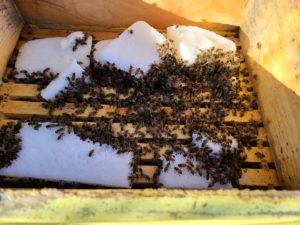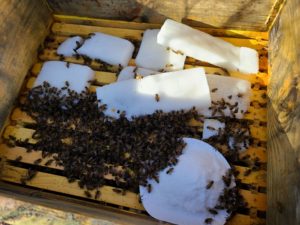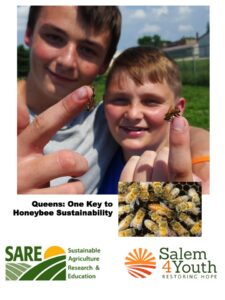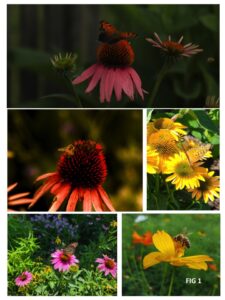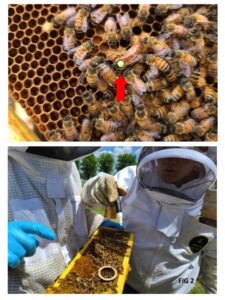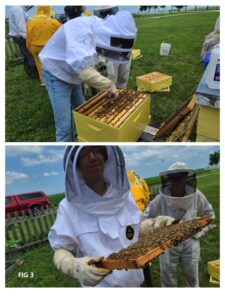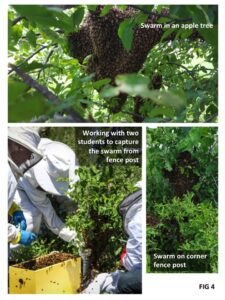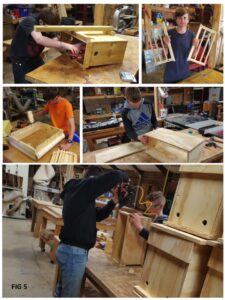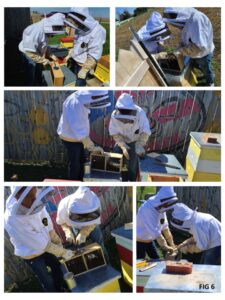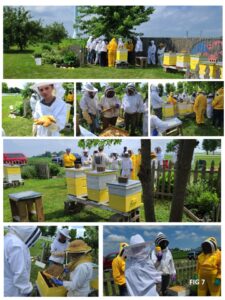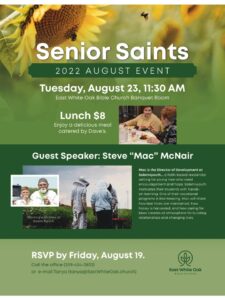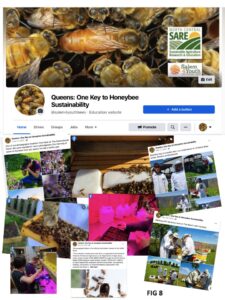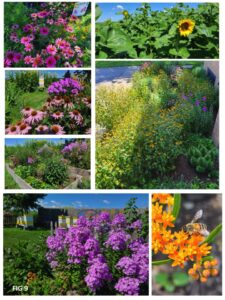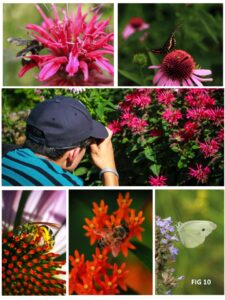Final report for YENC20-151
Project Information
One important facet of food sustainability is a healthy pollinator population. We will provide hands-on opportunities for students to produce local queens and colonies emphasizing this fact. They will learn that they can have an impact on their food future. This project will provide students with hands-on instruction in honeybee queen rearing from the egg stage through introduction of a new queen into a hive. It will also show students the value of local queens to hive success.
"Beekeepers who have success with new colonies tend to be those who are using locally produced queen bees installed into colonies that were produced from local bees, they that survived winter or periods of extreme stress. Any step toward localization of genetic stock and bees tends to move the beekeeper to a higher level of success." - American Bee Journal, 10/15
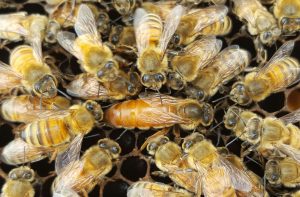
- Educate students on the importance of pollinators to our very survival and the environmental factors that have an impact on pollinator survival.
- Students hands-on involved, from egg to queen.
- Host a community education seminar regarding pollinators and planting for pollinator sustainability.
- Use social media throughout the project to share progress and results, and create awareness.
- Enhance the pollinator forage here on the ranch through students planting native plants.
- Have an article published about the project in The American Bee Journal.
Educational & Outreach Activities
Participation Summary:
2021 was the year wherein we were able to do the bulk of our project. Please see the results and discussion under the learning outcomes section of this report for an account of project activities and lessons learned.
From our progress report:
2020 was a tough year to implement some of the activities we were planning. As a residential program with COVID we had to be extremely careful with the comings and goings here on campus. For a good part of the year parents weren't even allowed to visit their sons so as to try to keep us COVID free. No outside folks (contractors, guests, etc) were allowed either. We had plans for hosting a couple of seminars here with the community and the boys regarding queen rearing, etc. Those had to be cancelled. The good news is that we are looking to try to make those happen this year!
With the worst of winter passed there is an excitement on the part of several of the boys to start working with the bees. We are also grateful that of our 13 hives, 12 look like they survived the winter. The queen rearing instructor who agreed to help us last year is on-board for this year too and is excited to work with the boys. At this point he has suggested a couple of dates in the June-July time frame to host a couple of seminars for the boys and the community at large here on our campus.
Learning Outcomes
Summary and highlights from our SARE Grant Report: Salem4youth YENC20-151
“I’m afraid of bees!”
“I got stung last time I was around bees”
“I think I’m allergic to bees.”
“Ahhh, maybe…”
“Will I get stung?”
“Maybe I will give it a try.”
“Yep!”
When asked if they would be interested in helping with the apiary here on The Salem4youth Ranch these are some of the comments made by boys over the years. Although beekeeping is something that maybe they’ve heard about or they may even have known someone who kept bees, none of the boys have actually opened and worked a honeybee hive. To them any insect that flies and stings is a bee. After further conversations it usually turns out that they were stung by a wasp after intentionally, or unintentionally, disturbing a nest. After I assure them that we will “suit up” with a veiled vest and gloves, most if not all, are willing to give it a go!
Salem4youth Ranch is a faith-based residential program designed to help families who are in a “season of struggle” with their teenage son. Salem serves boys ages 12-17 years old. Students live on campus and are generally in residence for 12-15 months. The primary goal of the program is familial reconciliation. The students attend school on campus, online, and also participate in Salem’s vocational classes. Participation in the beekeeping program is voluntary although many of the boys elect to give it a go.
Salem’s apiary program has added a unique dimension to the overall student experience. They not only have the opportunity to “work” the hives but each year one of the highlights of the apiary initiative is the harvesting of honey. All of the students willingly and enthusiastically participate in the harvesting/cutting of the honey. It is fun to watch a young man go from “I don’t like honey” to “Oh my goodness, this is amazing! Yum!” while chewing on the wax cappings which typically are covered with residual honey. In fact, we have to have them curb their enthusiasm so as to keep them from overindulging and getting an upset stomach from too much sugar! We bottle the honey and make it available for sale to parents of the boys and to the general community. Raw local honey is a very popular commodity. Sale of the honey helps offset the cost of the apiary as well as help to go toward the overall operation of the Salem4youth program. We call it “Bees Helping Boys!”
Because Salem4youth Ranch is a faith-based non-profit the SARE grant was truly a blessing to our apiary program. Our apiary efforts are primarily designed for educating the young men in our charge as to the importance of pollinators, particularly honeybees, to our very survival. A beehive is such an amazing organism and there are life lessons to be learned from how honeybees operate. Cooperation and community are the keys to the hive’s survival. So when we are working our hives there are spontaneous conversations, not only about bees, but also about life in general.
Project Objectives:
Educate students on the importance of pollinators to our very survival and the environmental factors that have an impact on pollinator survival.
One facet of the initiative that pleasantly surprised me is how many of the boys were aware of the importance of pollinators to their daily life. Whether this was something they learned in their school back home or read about it, their understanding pleasantly surprised me. Although we focused our efforts on understanding the importance of the honeybee we were able to observe a variety of native pollinators working the flowers in our various pollinator gardens and fields. They understand that honeybees are not really native to the U.S. but were brought here many years ago and that honeybees are essential to our food supply.
“One third of the food we eat comes from pollination due to honeybees. To put it simply, it is about one in every three bites of food. This may seem like a small number, but think of it like this, one third of the pollination is done from one species of bees” (American Entomologist, Volume 64, Issue 3, Fall 2018)
One facet of The Ranch vocational program is our Photography class. One unit in this class is instruction on how to do Macro photography. Popular subject matter for this unit tends to be various pollinators on flowers, such as in the image below (Fig. 1).
As the boys photograph various pollinators they are struck with the variety, as well as, importance of these little creatures to our very survival. They have learned that the honeybee is the only insect whose food (honey) is consumed by human beings. We also have labeled our salad bar noting which fruits and vegetables are pollinated by honeybees.
Since honeybees are so critical to our food supply we share with the boys how important it is to be aware of chemicals used in this rural, monoculture farming area. This chemistry is applied with either air tractors/spray planes or ground based vehicles. The use of chemicals has definitely had an impact on the soil, and water quality, which then affects pollinator health and sustainability. Climate challenges can also affect when nectar flows take place. This variation can also have an affect on overall colony health.
Students hands-on learning involved from egg to queen
The best way for our students to learn about “egg to queen” is to don a veil and vest and “dive into a hive.” This is something SARE helped make possible for the boys. For them to actually see, in the context of pulled comb, eggs, larva, pupa capped brood, and then having the opportunity to see a bee emerge from the capped cell is key to their understanding of the life cycle of a honeybee. By “pulling” frames they have the opportunity to locate the colony’s queen and “mark” her if her mark/dot has worn off. The boys learn that each year the color of the dot changes depending on the year the queen was born. This is an internationally accepted practice. The color corresponds to each year. White (years ending in 1 or 6), Yellow (years ending in 2 or 7), Red (years ending in 3 or 8), Green (years ending in 4 or 9) and Blue (years ending in 5 or 0). So in 2022 the queen is marked with a Yellow dot.
(Fig. 2) A marked queen and a student marking a queen on a frame).
If the spot on the queen has worn off the boys had the opportunity to re-mark the queen. Often times it is a challenge for any beekeeper to find the queen, especially if her dot has worn off, so the boys had fun finding her. In the mix of the bees on a frame it can be a case of finding her quickly or just seeing the evidence of her presence through seeing eggs down in the comb.
The boys also learned about queen cups and cells and what they indicate. Typically they are an indicator that the colony is preparing to swarm. We did splits with some of the existing hives if queen cells were present. They were able to see how by splitting a hive you create a new one without losing bees through swarming. Essentially they helped prevent a swarm while at the same time helped to create a new colony. The students had the opportunity over the years to handle multiple frames of bees and learn by doing.
It was particularly gratifying to watch them interact with the frames and with each other as seen in the photo below (Fig 3).
By understanding how to use “husbandry” with the bees the boys learn how to make the apiary more sustainable.
When we missed the timing and a hive swarmed the boys were able to “capture” the swarm. Typically prior to the swarm settling into their new home (one which was found by “scout” bees) the swarm tends to take up temporary residence in a nearby tree. They will cluster in the fork of a tree or on a branch (Fig 4) as they prepare to head out.
Ideally if we see the swarm there is a good chance that we can capture it. The boys did this by shaking the branch and the swarm typically will fall into an empty hive box. They learned that the key to successfully capturing the swarm was to make sure the queen was shaken into the box. Typically if the queen did shake into the box they were able to watch the swarm “march” into the box. This is an indicator that the queen is in the box. The swarm will follow the queen’s pheromone. Capturing a swarm is something the boys are fascinated with and really enjoy. With having a wood shop on the Salem campus the students also learn how to assemble wooden frames, and other beekeeping “wooden ware.”
They learn how to cut and assemble 5 frame nuc (nucleus) boxes that are used to house bees when starting a hive. Students also cut and assembled swarm “traps” that are typically hung on trees to capture swarms and hive them as depicted in the image below (Fig 5).
The boys also had the opportunity to graft an egg to make a queen. This involves using a special tool to gently remove a newly laid egg from comb. After carefully removing the individual egg they place it in a special plastic “cup” which is then affixed to a special frame. This is repeated until each cup has one egg. After they grafted eggs into these cups they placed the frame into a queenless hive. Because the hive is queenless the bees then start to put Royal Jelly into the cups and begin to build them into queen cells. The bees realize “No Queen, No Colony.” Each queen cell holds one queen. Once the queen cells are sealed they wait until the day the queen is likely to emerge and place her into a queen cage. They learned that the tricky part is timing the emergence of the new queens. The boys were amazed at all that goes into grafting yet were game to give it a go!
They also learned about other methods of making queens. We talked about how a virgin queen, once emerged from her queen cell, after a day or so, will fly to a DCA (Drone Congregation Area) where she mates with several drones (perhaps up to 50) and then heads back to the hive never to leave again unless she is part of a swarm sometime down the road. The boys were able to tell if the queen mating flight/s were successful by pulling a frame and seeing eggs in the comb or observing foraging bees bringing in pollen. They learned that pollen gathering is an indicator of brood in the nest since pollen is bee’s source of protein.
Learning and doing. Making queens is a unique skillset that they are learning. Having queens for making splits, re-queening a hive, or to make available to the general beekeeping public is something few boys their age, or even adults for that matter, will ever have the opportunity to learn. While a student here working in the apiary, he will continue to learn, hone and improve his knowledge base and gain confidence in what it takes to learn something new and unique.
Another unique opportunity for the boys was to “install” multiple packages of bees into “nuc” (nucleus boxes) (Fig 6).
A “package” is 3 lbs of bees and a mated queen. The students had the opportunity to install the bees and the queen cage (queen cage includes a mated queen and a couple of worker attendants) and then monitor how the bees eventually released the queen while at the same time “pulling” (make wax and form the comb) the comb so that the queen could begin to start laying her eggs.
The students also received instruction on the various ways of how to make a queen. They learn about Royal Jelly and the timeframes from egg to emergence for the three castes in a hive, the Queen (16 days), the Worker (21 days) and the Drone (24 days). By having the opportunity to work hands-on with the frames they could observe all three castes.
The boys were also involved in inspecting hives. Through these inspections they were able to see the difference between a “strong” and a “weak” hive. At one of our community training events in our bee yard they also learned how to replace an underperforming queen with a new, mated queen.
The boys also learned to tell the difference between capped brood and capped honey on a frame. This will come in handy when we pull frames for harvesting honey in a few weeks from now.
_______________________________________________________________________
Host a Community Education Seminar regarding pollinators and planting for pollinator sustainability
Due to the craziness and unpredictability of the pandemic and the extension on this grant we actually were able to host three Community Education Seminars. We opened these seminars up to beekeepers and community folks interested in beekeeping and pollinators in general. These seminars were well attended and essentially focused on inspecting existing hives and using what we found to focus our teaching around. We also had groups of our students attend each of these seminars. One was in 2021 and the other two were in 2022. We had more scheduled but the pandemic created challenges for us, and the potential attendees.
I am pleased to report that interest was high at each of these seminars. Each gathering lasted between 3-5 hours. Essentially what we did was go through the hives giving our students and community guests the opportunity for hands-on training and for MANY questions. The seminars were hosted here on The Salem4youth Ranch and were facilitated by two extremely knowledgeable and experienced beekeepers, one of which is a Master Beekeeper. Steve “Mac” McNair, Salem’s beekeeper, has had opportunities to talk to various community members about beekeeping and specifically the impact it has had on the boys who have spent time at The Ranch.
Salem’s bee yard is surrounded with strategic/intentional forage. We have worked to design the forage so that, as best we can, something will be blooming throughout the summer and into the fall so as to provide both critical nectar and pollen. We also have been developing a white clover field and wildflower meadow adjacent to the bee yard. We also have about an 1/8 of an acre of sunflowers planted that will be in full bloom in August. During each of the seminars the topic of intentionally planting forage/various forbs was discussed with the attendees. The importance of varied forage vs. monoculture forage was also highlighted. The key take-away was we need to do all we can to provide a variety of forage to have healthy bees. Another take-away was the value of planting native plants and plants/seeds that are not treated systemically with insecticides like neonicotinoids.
We have also have had positive interactions with our neighbor/farmers regarding the apiary and ways that we can keep the channels of communication open. We continue to promote with them the value of the planting of forage such as clover in their waterways. Our neighbor farmer likes to keep his waterways mowed but clover can/will still thrive even when mowing takes place. He is open to planting clover in the waterways. Yet, open dialogue is another way to assist in the sustainability of our bees and other native pollinators. Speaking of mowing, we have intentionally set The Ranch’s mower deck to the highest setting (5 ¼”) so that we can keep the extensive lawns mowed while also accommodating the clover growing throughout the spring and summer.
We had local guests attend the seminars and guests from as far away as two hours (Fig 7).
We are also hosting a seminar regarding our project with area Seniors in August 2022 to continue to share the project with our community.
____________________________________________________________________
Use Social Media throughout the project to share progress and results, and to create awareness
We created a Facebook page called Queens: One Key to Honeybee Sustainability (Fig 8).
We worked to post photos of the various activities from throughout the years. These posts include photos; updates and links to various video clips that we thought would be of interest to the visitor. We have also featured this information on the Salem4youth Facebook page.
The CIBA (Central Illinois Beekeepers Association) is the largest beekeeping association in Central Illinois. Throughout the project we shared posts from the “Queens” page to the CIBA site. This allowed interested folks to not only learn about what was going on with the grant and The Ranch but also influenced the strong turnouts to the training sessions that we hosted on the Salem campus.
_____________________________________________________________________
Enhance the pollinator forage here on The Ranch through students planting native plants
Dr. Jamie Ellis from the University of Florida cites three challenges to honeybee health. He calls them “The 3 Ps.” They are “parasites, pesticides and poor nutrition.” Maintaining our hives in rural Illinois we deal with all three challenges. We work on treating for parasites through IPM (Integrated Pest Management) practices, we register our hives with the local “Drift watch” program (growers alert beekeepers as to when they are planning on spraying chemicals), and that leaves nutrition. Having our hives in the land of row crops (acres of monoculture crops) we continue to intentionally plant a variety of forage that bloom throughout the spring into fall. Just as with humans, a varied diet of food contributes to overall health.
Due to the importance of providing forage for native pollinators, as well as for our honeybees, we are making a very concerted effort to provide this forage. Various individuals and companies, as well as the SARE initiative who understand the value of these plantings, have helped by providing some funding to begin our efforts to purchase and plant native perennial flowering plants. The students also did starts from seed under the grow light in the “Bee room” on campus.
The result is the planting of pollinator gardens around campus as seen in the image below (Fig 9).
Various students assist in the construction, planting and maintenance of both the raised and traditional gardens. They see firsthand the various pollinators enjoying the forage.
We are in the process of working to create a pollinator “oasis” in the sea of row crops. Row crops surround the Ranch each year (corn or soybeans). The SARE grant also allowed us to enhance the forage for both honeybees and native pollinators. We have made an effort to cooperate with the growers, specifically with the honeybees, to communicate if/when they plan to spray their crops with any of the various chemicals. This communication allows us to close up the hives prior to spraying.
We also encouraged the growth of milkweed for Monarch Butterflies adjacent to the bee yard. Our honeybees also “work” the Milkweed and Cupflowers that have “volunteered” and begun to spread over the past couple of years. We have also intentionally planted Dill plants. Dill plants are what Swallowtail caterpillars feed on and we have seen a marked increase in these beautiful butterflies. We have also planted a wildflower meadow on our campus. This was our first year and it is important that we are patient and do the necessary work to make this meadow grow. Typically it takes up to 3 years to have a thriving wildflower meadow and also it requires ongoing maintenance to be successful. We have also planted a field of white clover this year for our bees and native pollinators.
A beautiful result too of this initiative is how this intentional planting of forage has provided native pollinators with safe, non-toxic, nesting areas. Particularly solitary bees, many of which are ground nesters.
Having intentionally planted natives and other pollinator friendly forage has afforded wonderful “subject matter” for our boys who are in our photography vocation class.
The above image (Fig. 10) depicts just a few examples of the various forage and pollinators who visit The Ranch that the boys have photographed.
I want to refer back to the “3 Ps” from Dr. Ellis that was mentioned earlier that have an impact on hive health, Parasites, Pesticides and Poor Nutrition. We have been very intentional in providing good, and varied, nutrition to our honeybees and other pollinators. Nutrition is one of the keys to Queen health and colony health as well. It is easy to see how nutrition could be overlooked when you are battling Varroa mites and are very sensitive regarding the use of chemicals near the honeybees and other pollinators. If we want our apiary to be viable and sustainable we cannot forget nutrition before, during and after the main nectar flow.
Have an article published about the project in The American Bee Journal
The following is what we submitted to The American Bee Journal for their consideration recognizing the SARE grant and the impact it made here on The Ranch. I also attached 5 photos. These photos featured students as well as one of the community events:
(note: I have heard back from the editor and he had a few questions/clarifications that I will be working on. If they decide to accept the article I will send you the file.)
“Yeah, but will I get stung?!”
“If you give a man a fish, you feed him for a day. If you teach a man to fish, you feed him for a lifetime.”
I am not certain of the origin of that well known quote about teaching a man to fish but the same can be said about beekeeping.
“If you give a boy a taste of honey he’ll be satisfied for a day. If you teach a boy about beekeeping, he’ll have honey for a lifetime.”
Salem4youth Ranch is a non-profit, faith-based, residential program for teenage boys located in rural Central, Illinois. These boys are in a season of struggle at home and come to The Ranch to work on reconciliation and restoring their relationship with their parents. They are typically on The Ranch for 12-15 months.
Salem was founded in 1896 as an orphanage for both boys and girls. Over the years it has transitioned into what it is today where we serve teenage boys, ages 12-17 years old and their families.
In 2020 The Ranch was awarded a grant from SARE (Sustainable Agriculture Research & Education). The grant was specifically earmarked for Salem’s beekeeping efforts in educating our students, and the community at large, regarding the art of beekeeping and the importance of the queen to colony health and wellbeing.
Salem has had an apiary now for ten years. Over these years many young men have had the opportunity to have hands-on experience with honeybee colonies. Currently Salem maintains 20 hives in two locations. The majority of the hives are on the Salem’s campus. Participation in the beekeeping efforts is strictly voluntary although the curiosity of the boys generally means they will don a vest and veil and “dive in.”
Initially we hear comments from the boys like “I’m not a fan of bees, I got stung once” or “if I wear a suit will I get stung?” or “If he does it, I’ll do it.” After they express their trepidation, and are assured that it will be okay, they give it a shot. Once they do give it a try, they’re hooked! Rarely do they ever get stung. It’s all about educating and assuring them that they will do fine.
In a hive the queen is critical to that hive’s success. Typically as the queen goes, so goes the hive. The SARE grant gave the boys a unique educational opportunity to work with bees from installing a 3 lb. package of bees into a 5 frame nuc box, then moving the nuc box frames into a 10 frame hive eventually adding supers and then to ultimately harvesting honey. Throughout the process the boys had hands-on experience inspecting and maintaining a hive.
Through the grant we were also able to host beekeepers and local folks interested in beekeeping. We actually hosted members of the community three different times at The Ranch’s apiary giving them the opportunity to have hands-on instruction. Some of the attendees came from as far as 2 hours away. We were fortunate to have experienced beekeepers facilitate these gatherings, one of them actually being a Master Bee Keeper.
Another goal of the grant was to educate the general public regarding the necessity of native and honeybee pollinators to our daily food supply. We also stressed the importance of providing varied forage for these pollinators through intentional plantings. Over the years, particularly here in central Illinois, much of the natural forage ground has been planted with row crops so pollinators have lost extensive food resources. By informing the general public about the advantages to intentional pollinator friendly planting in their home flower gardens perhaps a portion of that loss can be offset.
Another facet to the grant was to create and maintain a social media presence. We chose to use Facebook and created and maintained a page “Queens: One Key to Honeybee Sustainability.”
We believe the key to pollinator sustainability is education. We are so grateful for the kindness and foresight on the part of SARE in helping to educate both the boys here on The Ranch and our community neighbors regarding the importance of pollinators to our very future. Honeybees are such unique creatures and a hive is a tremendous teaching tool about life. A hive provides life lessons regarding cooperation for the overall good. A hive operates essentially as one organism with all of the bees working together for the overall good and sustainability of colony. Individual honeybees are social creatures and cannot survive independent of the hive. The example of how a hive operates/thrives is not only a wonderful life lesson for teenage boys but also for the general public. Consider the honeybee!
Article submitted by: Steve “Mac” McNair, Salem4youth
Salem4youth.com Facebook: salem4youth
Salem4youth, 15161 N. 400 East Rd., Flanagan, IL 61740 phone: 815.796.4561
Project Outcomes
Initially we hear comments from the boys like “I’m not a fan of bees, I got stung once” or “if I wear a suit will I get stung?” or “If he does it, I’ll do it.” After they express their trepidation, and are assured that it will be okay, they give it a shot. Once they do give it a try, they’re hooked! Rarely do they ever get stung. It’s all about educating and assuring them that they will do fine.
“I’m afraid of bees!”
“I got stung last time I was around bees”
“I think I’m allergic to bees.”
“Ahhh, maybe…”
“Will I get stung?”
“Maybe I will give it a try.”
“Yep!”
When asked if they would be interested in helping with the apiary here on The Salem4youth Ranch these are some of the comments made by boys over the years. Although beekeeping is something that maybe they’ve heard about or they may even have known someone who kept bees, none of the boys have actually opened and worked a honeybee hive. To them any insect that flies and stings is a bee. After further conversations it usually turns out that they were stung by a wasp after intentionally, or unintentionally, disturbing a nest. After I assure them that we will “suit up” with a veiled vest and gloves, most if not all, are willing to give it a go!
In a hive the queen is critical to that hive’s success. Typically as the queen goes, so goes the hive. The SARE grant gave the boys a unique educational opportunity to work with bees from installing a 3 lb. package of bees into a 5 frame nuc box, then moving the nuc box frames into a 10 frame hive eventually adding supers and then to ultimately harvesting honey. Throughout the process the boys had hands-on experience inspecting and maintaining a hive.
Through the grant we were also able to host beekeepers and local folks interested in beekeeping. We actually hosted members of the community three different times at The Ranch’s apiary giving them the opportunity to have hands-on instruction. Some of the attendees came from as far as 2 hours away. We were fortunate to have experienced beekeepers facilitate these gatherings, one of them actually being a Master Bee Keeper.
